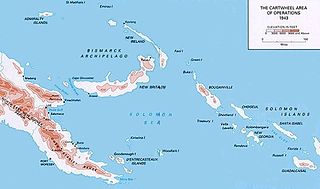
Operation Cartwheel (1943–1944) was a major military operation for the Allies in the Pacific theatre of World War II. Cartwheel was an operation aimed at neutralising the major Japanese base at Rabaul. The operation was directed by the Supreme Allied Commander in the South West Pacific Area (SWPA), General Douglas MacArthur, whose forces had advanced along the northeast coast of New Guinea and occupied nearby islands. Allied forces from the South Pacific Area, under Admiral William Halsey, advanced through the Solomon Islands toward Bougainville. The Allied forces involved were from Australia, the Netherlands, New Zealand, the US and various Pacific Islands.

The New Georgia campaign was a series of land and naval battles of the Pacific campaign of World War II between Allied forces and the Empire of Japan. It was part of Operation Cartwheel, the Allied strategy in the South Pacific to isolate the Japanese base around Rabaul. The campaign took place in the New Georgia group of islands, in the central Solomon Islands and followed the Allied capture of the Russell Islands. The main fighting took place on New Georgia island itself, although significant actions also took place around the island chain throughout the campaign.

Operation Ke was the largely successful withdrawal of Japanese forces from Guadalcanal, concluding the Guadalcanal Campaign of World War II. The operation took place between 14 January and 7 February 1943, and involved both Imperial Japanese Army (IJA) and Imperial Japanese Navy (IJN) forces under the overall direction of the Japanese Imperial General Headquarters (IGH). Commanders of the operation included Isoroku Yamamoto and Hitoshi Imamura.

Vella Lavella is an island in the Western Province of the Solomon Islands. It lies to the west of New Georgia, but is considered one of the New Georgia Group. To its west are the Treasury Islands.

The Bougainville campaign was a series of land and naval battles of the Pacific campaign of World War II between Allied forces and the Empire of Japan, named after the island of Bougainville. It was part of Operation Cartwheel, the Allied grand strategy in the South Pacific. The campaign took place in the Northern Solomons in two phases. The first phase, in which American troops landed and held the perimeter around the beachhead at Torokina, lasted from November 1943 through November 1944.
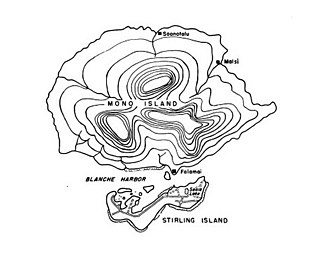
Treasury Islands are a small group of islands a few kilometres to the south of Bougainville and 24 kilometres from the Shortland Islands. They form part of the Western Province of the country of Solomon Islands. The two largest islands in the Treasuries are Mono Island and the smaller Stirling Island. The deep water strait between these two islands is called Blanche Harbor.

The Solomon Islands campaign was a major campaign of the Pacific War of World War II. The campaign began with Japanese landings and occupation of several areas in the British Solomon Islands and Bougainville, in the Territory of New Guinea, during the first six months of 1942. The Japanese occupied these locations and began the construction of several naval and air bases with the goals of protecting the flank of the Japanese offensive in New Guinea, establishing a security barrier for the major Japanese base at Rabaul on New Britain, and providing bases for interdicting supply lines between the Allied powers of the United States and Australia and New Zealand.

The Battle of the Treasury Islands was a Second World War battle that took place between 27 October and 12 November 1943 on the Treasury Islands group, part of the Solomon Islands. The battle formed part of the wider Pacific War and involved New Zealand and US forces fighting against Japanese troops. The majority of the ground forces were provided by the New Zealand 3rd Division.
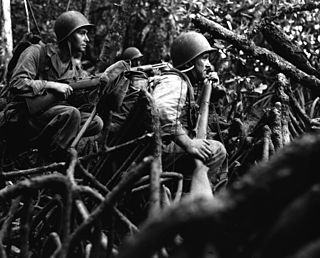
The Battle of Vella Lavella was fought from 15 August – 6 October 1943 between Japan and the Allied forces from New Zealand and the United States at the end of the New Georgia campaign. Vella Lavella, an island located in the Solomon Islands, had been occupied by Japanese forces early during the war in the Pacific. Following the fighting around Munda Point, the Allies recaptured the island in late 1943, following a decision to bypass a large concentration of Japanese troops on the island of Kolombangara.

The Raid on Choiseul was a small unit engagement that occurred from October 28 to November 3, 1943, during the Solomon Islands campaign, and was launched to divert Japanese from the Allied landings at Cape Torokina, on Bougainville Island. During the raid, United States Marines from the 2nd Parachute Battalion, landed on Japanese-occupied Choiseul in the northern Solomon Islands and carried out raids on Japanese army and navy forces over a 25-mile (40 km) area over the course of seven days with the assistance of local Choiseul islanders and an Australian coastwatcher. The force was withdrawn back to Vella Lavella by landing craft following the successful lodgment of US troops on Bougainville.
Buka Airport is an airport serving Buka Island in the Autonomous Region of Bougainville in Papua New Guinea.

The Landings at Cape Torokina, also known as Operation Cherryblossom, took place at the beginning of the Bougainville campaign in World War II. The amphibious landings were carried out by elements of the United States Marine Corps in November 1943 on Bougainville Island in the South Pacific, as part of Allied efforts to advance towards the main Japanese base around Rabaul under Operation Cartwheel. Coming in the wake of Allied successes at Guadalcanal and in the central Solomons, the landings were intended to secure a beachhead with the purpose of establishing several bases from which to project air and naval power closer towards Rabaul, in an effort to neutralize the large Japanese force that had been established there.

The New Georgia counterattack was a counterattack on 17–18 July 1943 by mainly Imperial Japanese Army troops against United States Army forces during the New Georgia campaign in the Solomon Islands. The U.S. and its allies were attempting to capture an airfield constructed by the Japanese at Munda Point on New Georgia with which to support further advances towards the main Japanese base around Rabaul as part of Operation Cartwheel.

The Battle of Munda Point was a battle, from 22 July – 5 August 1943, between primarily United States Army and Imperial Japanese Army forces during the New Georgia Campaign in the Solomon Islands in the Pacific War. The battle took place following a landing by U.S. troops on the western coast of New Georgia from Rendova, as part of an effort to capture the Japanese airfield that had been constructed at Munda Point. This advance had become bogged down and while the Allies brought forward reinforcements and supplies, the Japanese had launched a counterattack on 17–18 July. This effort was ultimately unsuccessful and afterwards U.S. forces launched a corps-level assault to reinvigorate their effort to capture the airfield. Against this drive, Japanese defenders from three infantry regiments offered stubborn resistance, but were ultimately forced to withdraw, allowing U.S. forces to capture the airfield on 5 August. The airfield later played an important role in supporting the Allied campaign on Bougainville in late 1943.
Balalae Island is an island of the Shortland Islands Group in the Western Province of the Solomon Islands.
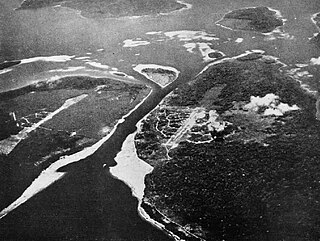
Between 9 March and 5 April 1942 during World War II, forces of the Empire of Japan occupied the islands of Buka and Bougainville in the South Pacific. At that time these islands were part of the Australian-administered Territory of New Guinea. A platoon of Australian commandos from the 1st Independent Company was located at Buka Airfield when the Japanese landed but did not contest the invasion.

Operation I-Go was an aerial counter-offensive launched by Imperial Japanese forces against Allied forces during the Solomon Islands and New Guinea Campaigns in the Pacific Theater of World War II. Taking place from 1–16 April 1943, during the operation, Japanese aircraft – primarily from Imperial Japanese Navy units under the command of Admirals Isoroku Yamamoto and Jinichi Kusaka – attacked Allied ships, aircraft, and land installations in the southeast Solomon Islands and New Guinea. The goal of the operation was to halt the Allied offensives in New Guinea and the Solomons and to give Japan time to prepare a new set of defenses in response to recent defeats to the Allies in the Battle of Guadalcanal and in New Guinea at Buna–Gona, Wau, and the Bismarck Sea.
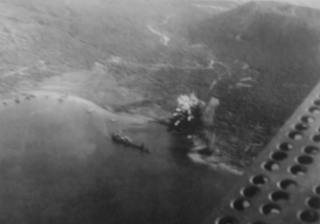
Rabaul is a town in Eastern New Britain, Papua New Guinea. Japanese forces landed on Rabaul on 23 February 1942, capturing it in February of that year. The former Australian territory was transformed into a major Japanese naval and air installation. The Japanese heavily relied on it, and used it as a launching point for Japanese reinforcements to New Guinea and Guadalcanal. Throughout the Solomons Campaign, neutralizing Rabaul became the primary objective of the Allied effort in the Solomons.
Ro-100 was an Imperial Japanese Navy Ro-100-class submarine. Completed and commissioned in September 1942, she served in World War II, operating in the Solomon Islands, Rabaul, and New Guinea areas. She sank in November 1943 when she struck a mine during her seventh war patrol.
Ro-103 was an Imperial Japanese Navy Ro-100-class submarine. Completed and commissioned in October 1942, she served in World War II, operating in the Solomon Islands, Rabaul, and New Guinea areas and sinking two cargo ships. She disappeared in July 1943 during her fifth war patrol.















